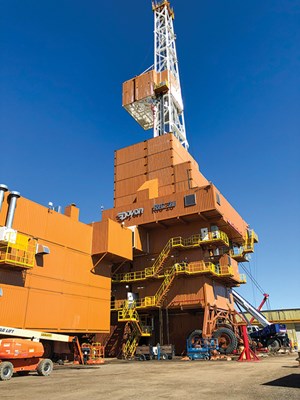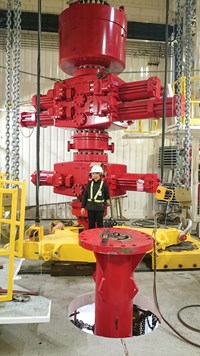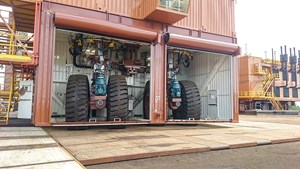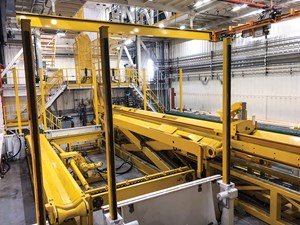Unique collaboration produces landmark rig design

As the oil and gas industry concentrates increasingly on drilling long horizontal laterals, the necessity for improvements in rig design becomes more apparent. When operating in areas with considerably less infrastructure and greater environmental challenge, like the North Slope of Alaska, more than just mechanical changes are necessary; innovation becomes a driving force. To meet the needs of one customer, National Oilwell Varco (NOV) collaborated with Doyon Drilling to design and manufacture one of the world’s largest, most advanced drilling rigs, the Doyon 26, Fig. 1.
CULTURE AND HERITAGE
The concept for a next-generation, extended-reach drilling (ERD) rig was conceived in 2011 by two industry veterans, Ron Wilson of Doyon Drilling and Ron Sorokan of NOV, the latter of whom had previously founded Dreco Energy Services. After extensive collaboration, the idea for Doyon 26 was born and built to the point that it could be transformed from conception to reality. The concept was submitted to NOV in 2015 for a front-end engineering design (FEED) study that would allow further refinements, which would result in an actual rig that could be ordered and built by a client.
Doyon 26 was conceived, engineered, and built on 40 years of lessons learned between Doyon Drilling and Dreco. The rig’s heritage dates to 1981, built on a foundation of highly technical, engineered DNA, combining HR talent and technology from both companies. The rig that Doyon Drilling was working on at that time, Doyon 9, was a joint venture between Doyon Drilling and Nugget Drilling. Dreco was given the opportunity to engineer and build the rig—one of the earliest Prudhoe Bay rigs—that set the foundation for a long, productive relationship.
By the late 1980s, Doyon Drilling and Dreco had successfully built four rigs together. Although the majority of the engineering talent originally involved with the innovation produced by the two companies had retired, Doyon 26 was made possible by utilizing a foundation of innovation that came before the current rig builders. These relationships, which were forged by employees from both companies, stayed in their respective companies for 40 years and were tapped for this rig building. This knowledge was handed down over the years in an act of truly generational mentorship. To have a shared journey without a finish line, and learning from challenges of the past, a collective knowledge increase ensues, benefitting both companies. Adopting a similar model would clearly benefit the modern oil and gas industry, particularly as economic conditions have driven talent to other industries.
DESIGNING WITH 3D SOFTWARE
The use of advanced 3D modeling has changed the way that engineering interacts with all other stakeholders in the design and building of large-scale rig projects. Within the 3D model, designers and engineers were able to fully visualize the entire project, from a birds-eye view down to individual pipe fittings. The model even accounted for human beings and how they’d interact with the equipment and space around them. The 3D model combined structure with machine components, piping, electrical, HVAC, hydraulics, and any other details that needed to be added. Having all these details in a single “master model” allowed for design decisions to be made with all the information available, and fabrication drawings produced quickly and accurately. This maximized throughput between engineering and manufacturing.
These tools also have changed the way that customers provide feedback and can become an integral part of the design process. As the 3D model develops and more details are added, the customer can see the changes in a 3D virtual space, understanding the design challenges and providing feedback in real time as the design progresses. During the design phase of Doyon 26, there were over 70 model reviews and presentations, which included both NOV engineering and project management and Doyon operations and management. These collaborative sessions allowed both parties to work quickly through challenges and move the project forward. Engaging the customer in this way reduced the need for costly changes during manufacturing and rig-up, as all customer requirements were addressed in the design phase.
3D modeling is an integral process in engineering and design, but it is now being used as a tool in manufacturing, as well. Foremen in the fabrication facilities are using the model to look at how individual pieces fit in as part of the larger structure. They can use their wealth of experience to look for potential interferences, finding more efficient ways to build the components on the rig. This has reduced the amount of rework on the shop floor dramatically and improved assembly times during the rig-up phase of the project.
BUILDING “THE BEAST”

Doyon 26 is an ERD modular rig with an entirely custom design, each piece assembled carefully with near-surgical precision. The world’s largest mobile land rig is comprised of 12 fully enclosed modules, weighing in at 10.2 million lb of steel and equipment, that come together on the rig site. The modules include the following:
BOP module houses all the rig’s BOP and well control components, including the BOP itself (an 18¾-in., 5,000-psi Shaffer model); diverter stack; choke manifold; BOP accumulator; and integrated managed pressure drilling (MPD) system, Fig. 2.
Drilling module includes an alternating current (AC) electric moving system; skidding drill floor for transportation; the driller’s cabin with AMPHION control system and NOVOS process automation platform; and two iron roughnecks—one for well center operations, and one for offline standbuilding. The module also includes a 165-ft mast, top drive, drawworks, and a 7,500-psi high-pressure mud manifold.
Sub base holds the rig’s fully integrated pipe-handling system, Fig. 3.
Pipe shed module has the capacity for 15,000 ft of 13⅝-in. casing and includes 2,400 ft² of office space.
Mud system module has a 2,000-bbl mud system and 700-bbl water system with automated valves. All services connect to the drilling module through a single utility corridor.
Mud pump module has four National 14P-220 mud pumps. The pumps provide 1,500 gpm at 5,000 psi and 1,200 gpm at 6,100 psi. In addition, the module includes two 150-hp boilers to provide steam heat throughout the rig and a natural gas conditioning skid for gas distribution throughout the rig.
Engine module has eight CAT 3512 dual-fuel gensets with hi-line power capability. For perspective, this is enough to provide power to 15,000 people.
Cuttings processing unit enables cuttings to be processed by grinding and then pumping the cuttings/slurry to an offsite processing facility.
Mobil workshop with space for welding and machining, as well as an overhead bridge crane for equipment servicing.
Mobil parts house storage trailer for easy access.

Drill floor transporter can be skidded to split the drilling module into two loads, if necessitated by transportation weight restrictions, Fig. 4.
Scissor jack to lift the drill floor transporter to working height to enable the drill floor to skid onto the transporter.
There are several unique aspects of the modules and capital equipment within them, including seven patents. The AC electric drive system allows the drilling module to be self-propelled, while an innovative steering system allows for perfect steering around curves to minimize tire wear. The self-propelled module’s driver’s cabin contains a joystick, two heads-up displays with all necessary programming, all controls for the rig, and a CCTV with a view from four cameras around the rig for the driving system. The steering system is based on the type of rack-and-pinion system typically seen in automobiles, a concept never explored with a rig of this size. Rack-and-pinion has geometry that effectively allows perfect steering, meaning that even on Doyon 26 the wheels point to one turning center—the rig can turn like a top about its center point, spinning on its axis and backing into place at the push of a button.
On the capital equipment side, both equipment specification and placement were critical. For the top drive, the operator knew that to push out to the long laterals of ERD, they would have to have significantly higher torque values than typically seen on land systems, necessitating development of a new top drive. As the weight of an existing offshore top drive with capacity to handle the necessary torque is 50,000 lb greater than the mast can handle, the new unit is based on an existing TDS-1000 model with improved motors operating at much higher horsepower. This new TDS-1000H is the first and only model of its kind in the world. The racking board is more than 700 ft², holding 360 stands, or 35,000 ft, of total drill pipe. The ADS-30D drawworks provides 3,000 hp, with a maximum hookload on 14 lines of 719 mT.
Iron roughnecks optimize operations. The rig also incorporates two iron roughnecks. The primary roughneck, an ST-120, is for well center and mousehole applications, but a second unit, an ST-100, was added specifically for offline stand-building. To reduce NPT during drilling operations, the rig-crew can bring drill pipe up through the pipe chute, three joints of pipe at a time. Inside the racking board, a bridge crane is then used as a hoisting system, enabling the operator to come down and pick up three sets of pipe to the floor. The first two sets are grabbed and set in the hole, then the third is grabbed and stabbed into the first one. The iron roughneck is then used to make up the connection, the double stand is pulled up out of the hole and set in the next mousehole, and the iron roughneck comes a little further, torques up that last joint, and then the bridge crane can be used to position it, either in the setback or well center after drilling of that section of the well is done.
These are just a few of the innovations incorporated in the rig, but it’s a good overview of its technology before Doyon 26 begins drilling in 2020. The rig will be used on an upcoming drilling campaign on the Alaskan North Slope for a major operator at Alpine field. Each module has a unique composition—a total of 106 large wheels allows the module to be pulled down the road by trucks when traveling between pads, but when on site each module also has skid feet that can allow the module to be walked into position. NOV took the bearing pads and placed skid feed underneath them, allowing the operator to use hydraulic controls to move each piece into position more accurately as integrated models. This versatility virtually eliminates NPT and also allows fine-tuning of the rig’s positioning.
MINIMIZING FOOTPRINT
One other concern that the rig addresses is the need to minimize footprint. Doyon Drilling has long used new technology to minimize the impact of oil and gas development in the Arctic, leading the industry in innovation and speed of adoption. When operators began exploring the Prudhoe Bay oil field in the early 1970s, relatively simple well design was further restricted by existing technology. On a single 65-acre gravel pad in 1970, for example, even directional drilling would not allow for wells to be drilled in a radius of more than 3 mi2.
In 2016, technology saw this number grow to approximately 55 mi2 on only a 12-acre pad. This means that pads can be spaced farther apart and that the environment can be protected with little or no surface disturbance. The value of this concept has already been proven in a famous “penta-lateral” well in Kuparuk field, where five wells were drilled from a single surface wellbore. The five wells are now producing from various reservoir sands at different depths through three fault blocks. Twenty years ago, this would have been impossible, requiring several pads and multiple wells per pad.
Doyon 26 will enable even more challenging ERD campaigns. The rig is designed to drill up to 35,000 ft horizontally, representing some of the longest laterals in the world. Because of this capability, the rig will be able to drill wells covering 125 mi2 from a single surface well pad. Not only does this improved well design in ERD dramatically change environmental impact and footprint—well pads are now between 70% and 88% smaller than a few decades ago—but it allows operators to develop and produce previously untapped oil resources, like those of Alpine field, from existing surface infrastructure.
Building on the past; focused on the future. Conceiving and building one of the largest, most advanced mobile land rigs was not without challenges. But integrated groups of technical experts, 3D modelers, structural engineers, and countless other professionals made it possible. Key aspects to the engineering and manufacturing success was knowledge-sharing and a cooperative team effort. The ideas of those who came before will continue to shape the path of rig technology going forward. Although our industry employs some of the world’s most talented and engineering-savvy people, we also must create a culture of mentorship to mitigate knowledge loss and pass along experiences for posterity.
- The Houston Echo Chamber (December 2023)
- Rig electrification drives down emissions, bolsters efficiency while improving onshore drilling economics (October 2023)
- Aramco’s EXPEC ARC pushes technical innovation and excellence (August 2023)
- Mobile electric microgrids address power demands of high-intensity fracing (July 2023)
- Utilizing electronic data captured at the bit improves PDC design and drilling performance (July 2023)
- Coiled Tubing Technology: How to plan a Coiled Tubing Drilling campaign (March 2023)
- Applying ultra-deep LWD resistivity technology successfully in a SAGD operation (May 2019)
- Adoption of wireless intelligent completions advances (May 2019)
- Majors double down as takeaway crunch eases (April 2019)
- What’s new in well logging and formation evaluation (April 2019)
- Qualification of a 20,000-psi subsea BOP: A collaborative approach (February 2019)
- ConocoPhillips’ Greg Leveille sees rapid trajectory of technical advancement continuing (February 2019)



